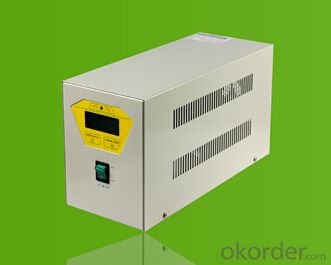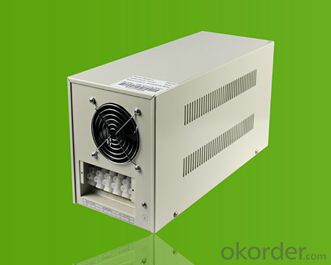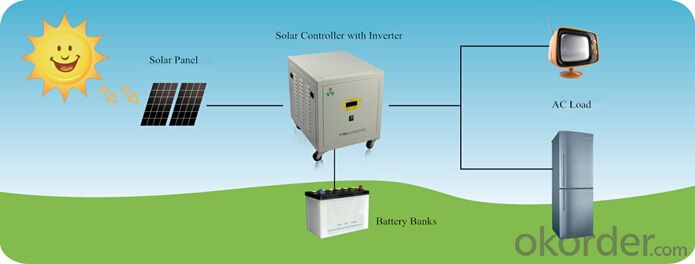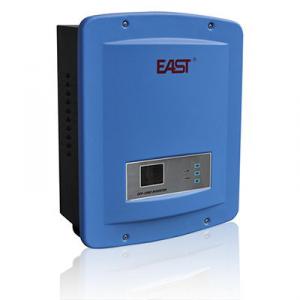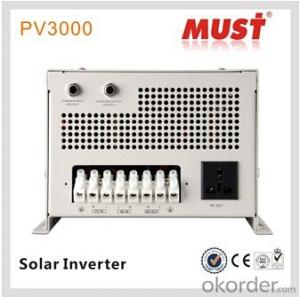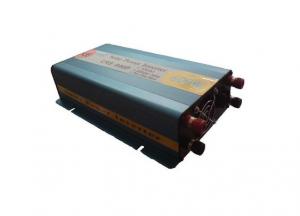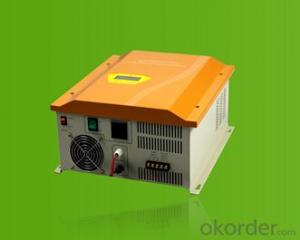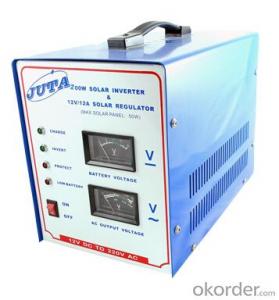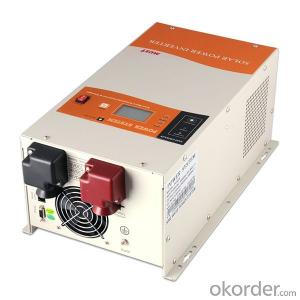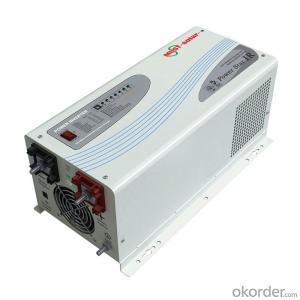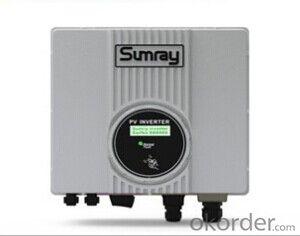16 Kw Solar Inverter with Solar Controller and Inverter 600W-1000W
- Loading Port:
- Shanghai
- Payment Terms:
- TT OR LC
- Min Order Qty:
- 1 unit
- Supply Capability:
- 8000 unit/month
OKorder Service Pledge
OKorder Financial Service
You Might Also Like
I. PRODUCT INTRODUCTION
Solar controller with inverter is the intelligent power supply with integration of solar and DC to AV inverse. The apparatus is mainly used for solar power system; provide effective power for traffic inconvenience, the harsh environment of the mountain area, a pasturing area, border, islands and other areas without electricity. With decent appearance, easy operation, and visual indication of LCD, the apparatus has perfect protection function, high charging efficiency, and low no-load loss.
II. APPLICATION AREAS
Photovoltaic power station
Domestic household photovoltaic power system
Coastal islands, remote mountainous, border posts for regions shortage of or without electricity.
Government demonstration projects, landscape lighting projects, etc.
Mobile communication base station, expressway and other non-residential regions.
III. 600W-1KW TECHNICAL PARAMETERS
Product Model | WSI0606-24 | WSI1010-24 | WSI1010-48 |
Rated solar power | 600 W | 1000 W | 1000 W |
Floating charging voltage | 29 V | 29 V | 58 V |
Rated inverter output capacity | 600 VA | 1000 VA | 1000 VA |
Rated battery voltage | 24 V | 24 V | 48 V |
Over voltage shutoff | 34 V | 34 V | 68 V |
Over voltage recovery | 33 V | 33 V | 66 V |
Battery over-discharge shutoff | 21.6 V | 21.6 V | 43.2 V |
Battery over-discharge recovery | 24 V | 24 V | 48 V |
No-load loss current | ≤0.7 A | ≤0.7 A | ≤0.5 A |
Net weight | 10 kg | 12 kg | 12 kg |
Dimension | 402×163×202 mm | ||
Output wave | Pure sine wave | ||
Display mode | LCD | ||
Cooling | Fan | ||
Rated output voltage | 110/120/220/230/240 VAC | ||
Wave Distortion | ≤4% | ||
Output Frequency | 50/60±0.5 Hz | ||
Dynamic Response | 5% | ||
Power Factor | ≥0.8 | ||
Over-load Capacity | 120% 1min, 150% 10s | ||
Inverter Efficiency | Maximum 90% | ||
Isolating Mode | Frequency Toroidal Transformer | ||
Protection Level | IP20(Indoor) | ||
Noise (1m) | ≤40dB | ||
Insulating Strength | 1500VAC, 1min | ||
Protection Functions | Inverter input over-voltage protection; battery over-discharge protection; battery anti-reverse-connection protection; output over-load protection; output short circuit protection; overheating protection | ||
Ambient Temperature | -20~+55℃ | ||
Ambient Humidity | 0~93%, without condensing | ||
Working Altitude | ≤4000m | ||
In order to serve our customers better. Our company can adjust parameters configuration according to customer’s requirement. | |||
IV. APPENDIX
Optional Functions | |
Ø By-pass Function: It will switch to the city grid automatically when the battery is under voltage, which ensures the continuity and stability of system. | |
Ø English display function: It can display in English. | |
Friendly reminder: customers should provide the following information when ordering Solar Controller with Inverter | |
Ø Rated battery voltage | Ø Load power and load characteristics |
Ø Rated solar panel power | Ø Inverter output capacity |
Ø With or without by-pass function | Ø Rated output voltage and rated output frequency |
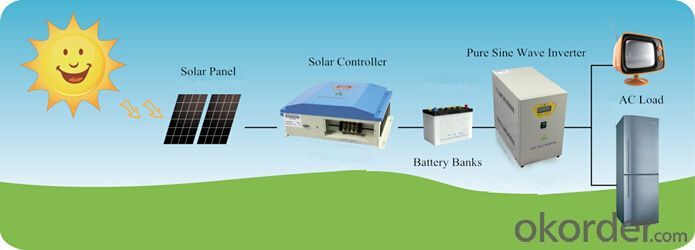
- Q: Can a solar inverter be used with a solar-powered water pumping system?
- Yes, a solar inverter can be used with a solar-powered water pumping system. A solar inverter is responsible for converting the direct current (DC) electricity generated by the solar panels into alternating current (AC) electricity, which is required to power the water pump. Therefore, a solar inverter is a crucial component in ensuring the efficient operation of a solar-powered water pumping system.
- Q: How does a solar inverter handle grid faults or disturbances?
- A solar inverter handles grid faults or disturbances by continuously monitoring the grid voltage and frequency. When a fault or disturbance is detected, the solar inverter quickly disconnects from the grid to ensure safety and protect the system. It then enters a standby mode until the grid returns to normal conditions. Once the grid stabilizes, the solar inverter reconnects and resumes its normal operation of converting solar energy into usable electricity.
- Q: How do you calculate the maximum power point current for a solar inverter?
- To calculate the maximum power point current for a solar inverter, you need to determine the maximum power point voltage (Vmpp) of the solar panel and divide it by the inverter's input impedance. This can be done by using the voltage-current (V-I) curve of the solar panel and locating the point where the product of voltage and current is maximized. By obtaining the Vmpp value, you can then calculate the maximum power point current by dividing it by the inverter's input impedance.
- Q: What is the operating temperature range of a solar inverter?
- The operating temperature range of a solar inverter typically falls between -20°C to 50°C (-4°F to 122°F), although this can vary depending on the specific model and manufacturer.
- Q: How do you connect a solar inverter to solar panels?
- To connect a solar inverter to solar panels, the DC output of the solar panels needs to be connected to the DC input of the inverter. This is usually done using appropriately sized and rated solar cables and connectors. The positive terminal of the solar panel is connected to the positive terminal of the inverter, and the negative terminal of the solar panel is connected to the negative terminal of the inverter. Properly following the manufacturer's instructions and guidelines is crucial to ensure a safe and efficient connection.
- Q: Can a solar inverter be used in a mobile or portable solar system?
- Yes, a solar inverter can be used in a mobile or portable solar system. In fact, it is a crucial component that converts the direct current (DC) generated by the solar panels into alternating current (AC) that can be used to power various devices and appliances. Portable solar systems often include a built-in inverter, allowing them to provide convenient and clean energy on the go.
- Q: How does a solar inverter handle grid faults and disturbances?
- A solar inverter handles grid faults and disturbances by constantly monitoring the grid voltage and frequency. In case of a fault or disturbance, the inverter immediately disconnects from the grid to ensure safety and protect itself from damage. It then goes into a standby mode until the grid stabilizes. Once the grid is back to normal, the inverter reconnects and resumes normal operation, ensuring seamless and uninterrupted power supply from the solar panels.
- Q: Are there any ongoing maintenance requirements for a solar inverter?
- Yes, there are ongoing maintenance requirements for a solar inverter. Regular inspections, cleaning, and monitoring of performance are recommended to ensure optimal functioning. Additionally, routine checks of electrical connections, firmware updates, and replacement of faulty components may be necessary to maintain the efficiency and longevity of the inverter.
- Q: How does the input power rating affect the performance of a solar inverter?
- The input power rating of a solar inverter directly affects its performance. A higher input power rating allows the inverter to handle a greater amount of solar energy, resulting in a higher energy conversion efficiency and overall performance. On the other hand, a lower input power rating may limit the inverter's capacity to handle larger solar systems, potentially leading to lower efficiency and reduced performance. Therefore, selecting an inverter with an appropriate input power rating is crucial to ensure optimal performance in a solar energy system.
- Q: What is the role of a solar inverter in preventing islanding?
- The role of a solar inverter in preventing islanding is to constantly monitor the electrical grid and disconnect the solar system from the grid when a power outage occurs. By detecting changes in grid voltage or frequency, the inverter ensures that the solar system does not continue to generate and supply power to the grid in isolation, which could potentially cause safety hazards for utility workers and damage to electrical equipment.
Send your message to us
16 Kw Solar Inverter with Solar Controller and Inverter 600W-1000W
- Loading Port:
- Shanghai
- Payment Terms:
- TT OR LC
- Min Order Qty:
- 1 unit
- Supply Capability:
- 8000 unit/month
OKorder Service Pledge
OKorder Financial Service
Similar products
Hot products
Hot Searches
Related keywords



